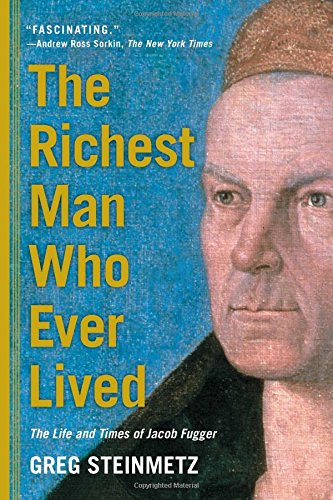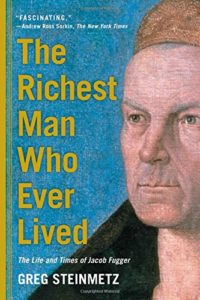
 Greg Steinmetz is a journalist with a passion for the past, whose recent work The Richest Man Who Ever Lived, focuses on the influential and bold (but not particularly likeable) sixteenth-century German banker Jakob Fugger (1459-1525). Although less well-known, Fugger’s impact on contemporary politics and business practices during the Renaissance was arguably as great as any shaped by members of the Medici, de Rothschild, or Rockefeller families. Steinmetz argues that Fugger “changed history because he lived in an age when, for the first time, money made all the difference in war and, hence, politics” (xiv). Specifically, Fugger’s banking and mining prosperity, which Steinmetz calculates amounted to nearly 2 percent of European economic output by 1520s, empowered him to elevate the political fortunes of early Hapsburgs – raising their level of influence to that of French and English royalty.
Greg Steinmetz is a journalist with a passion for the past, whose recent work The Richest Man Who Ever Lived, focuses on the influential and bold (but not particularly likeable) sixteenth-century German banker Jakob Fugger (1459-1525). Although less well-known, Fugger’s impact on contemporary politics and business practices during the Renaissance was arguably as great as any shaped by members of the Medici, de Rothschild, or Rockefeller families. Steinmetz argues that Fugger “changed history because he lived in an age when, for the first time, money made all the difference in war and, hence, politics” (xiv). Specifically, Fugger’s banking and mining prosperity, which Steinmetz calculates amounted to nearly 2 percent of European economic output by 1520s, empowered him to elevate the political fortunes of early Hapsburgs – raising their level of influence to that of French and English royalty.
For some time now, professional historians have been engaged in the challenge of trying to reach a wider public audience. Most recently, the call was made by Bill Cronon at his AHA Presidential Address in 2013.[1] In pursuit of this noble endeavor, historians can learn from Steinmetz. His biography of Fugger (rhymes with cougar) gets high marks for storytelling and historical context, but like many trade publications, leaves room for improvement; specifically the lack of original primary source investigation and historiographic contextualization.
Previously, scholars have noted the influence of Early Modern banking dynasties like the Medici and Welsers, but far less has been written on the Fuggers, especially in English. For those capable of reading German, works by Götz von Pölnitz, Jakob Strieder, Günter Ogger, and Mark Häberlein will be of interest.[2] Only Häberlein has been recently translated.[3] Steinmetz combines the older and familiar great man style prevalent in earlier works with Häberlein’s topical institutionalist interpretation; stressing both Fuggers business acumen and opportunism in the face of ever-present political and cultural boundaries that both constrain and enhance his economic ambition.
Steinmetz further differentiates his work by unabashedly weaving into the story comparisons of Fugger to twenty-first century businessmen. “We can easily see in Fugger a modern figure . . . He chased the biggest opportunities. He won favors from politicians. He used his money to rewrite the rules to his advantage. . .He was the first modern businessman in that he was the first to pursue wealth for its own sake [and] to understand our financial system and how we got it, it pays to understand him” (xvii). It is a shame Steinmetz did not directly engage in the lively historiographical debates taking place among liberal, Marxist, and culturally-minded scholars on the legacy and consequences of capitalism. Indeed, Steinmetz’ underlying message seems to be that we should look beyond the eighteenth and nineteenth centuries if our goals are to understand the institutional and cultural factors that shaped political-economies of the West.
Fugger was born in 1459 to a merchant family that had gained a good deal of money purchasing textiles from the local manufacturers of Augsburg and selling them at trade fairs in Frankfurt, Cologne, and Northern Italy. Originally destined for the seminary, Jakob was instead sent to Venice to apprentice in trade. Europe at the time was segmented into states, principalities, duchies, and empires of various sizes and Italian city-states since the eleventh century had functioned as intermediary points linking the Silk Road with the Romanesque cities north of the Alps. Living and working at the Fondaco dei Tedeschi, translated as “warehouse for German speakers,” it was there Fugger learned to read and converse in multiple languages, mastered conversion formulas for weights and currencies, and the art of negotiation. Most importantly, Steinmetz argues, the Venetians taught him the craft of accounting. While most German merchants “were still jotting down numbers on paper scraps that were never organized . . . Italians [had] more robust methods to handle large, multinational enterprises” – most notably double-entry bookkeeping which was “so named because each entry had a corresponding entry to make the books balance” (9-10).
Returning to Augsburg a few years later, Fugger witnessed what Steinmetz notes as another defining moment for the young merchant, the spectacle of Habsburg Emperor Frederick III desperately pleading with Fugger’s eldest brother Ulrich to lend him bolts of wool and silk cloth. Frederick, then the Holy Roman Emperor as well, was broke but wanted the fine textiles to impress Charles the Bold, then the wealthy and powerful Duke of Burgundy. Ulrich agreed to supply Frederick with the textiles and in exchange received a coat of arms with three lilies along with the Fugger brother’s named as recipients (15). The coat of arms helped lift the family into the upper echelons of Augsburg’s merchant class, while the event, Steinmetz suggests, likely impressed upon the young Jakob that even kings were beholden to the laws of money.
Indeed, sovereigns needed money to keep up appearances, to maintain buildings and services within their domain, and perhaps most importantly to wage war. Taxing the population was one way to raise funds; so too was taxing trade (tariffs). If the sovereign owned silver or copper mines, he could mint his own currency. Expropriation was certainly an option, though as with any redistribution of wealth, it is typically a one-time transfer reserved for emergencies and came with a serious downgrade in one’s credit (yes, kings had to worry about such things). Loans from wealthy Bürger (citizens) were also an option. With the growth of cities and trade starting in the eleventh century, merchants began accumulating significant amounts of Venetian ducats and Florentine florins.[4] Options for putting this capital “to work” were limited, however, to real estate, mines, trade, and loans. All forms of investment come with risks, but sovereign lending was particularly tricky considering the political nature of the relationship. The case of Archduke Sigmund of Innsbruck is illustrative.
In 1485, Fugger while still working for his brothers firm, lent three-thousand florins to the Habsburg duke and in return was consigned the right to a thousand pounds of silver in installments. “Fugger paid eight florins a pound and sold it in Venice for as much as twelve florins” (19). That was Fugger’s first experience as a banker, and planted the seed for an opportunity four years later when a border dispute broke out between Venice and Innsbruck.
The same Sigmund of Innsbruck to whom Fugger had lent the three-thousand florins had captured a town in the Alps that belonged to Venice. Venice had been preoccupied with fighting the Turks in Greece at the time, but soon took notice of the territorial violation. Venice immediately demanded that Sigmund return the town and pay them one-hundred thousand florins for their troubles, or face invasion. Sigmund quickly realized he was overmatched when his normal bankers denied his requests for funds – he had run up enormous debts and failed to make good on them. Without their financial support, Sigmund could not afford to pay off the Italians much less resist them in a military engagement. It was here that Fugger saw an opportunity and only he came to Sigmund’s rescue, agreeing to lend him the full amount. If Sigmund repaid, Fugger stood to make a fortune. Fugger drafted a contract that secured the loan by requesting that all the output from the Duke’s silver mines at Schwaz be directed to Fugger at a discount until the loan was repaid. The risk was huge and the Fugger family firm would be finished if Sigmund failed to deliver. “Sigmund was the law of the land. Like all royals, he could renege without consequences…The only things that kept him honest were his honor and his desire to borrow again in the future” (21).
In later chapters, Steinmetz documents how Fugger leant huge sums for Emperor Maximilian I’s armies in exchange for the rights to mine copper in Hungary. Chapter fourexamines the competition Fugger faced in other powerful merchant-lenders such as the Welsers and Hochstetters. He also faced competition from the famous North and Baltic Seas trade association, the Hanseatic League (chapter 5). Fugger persuaded Pope Leo X along with friend and scholar Johannes Eck to lift the restriction on moneylending by Christians in 1515. As a staunch Catholic, Fugger often paid for indulgences to absolve him of sin and bribed church officials for a myriad of favors. Fugger and others of similar standing were fiercely opposed by Martin Luther, one enemy whom he was unable to vanquish (chapter 10). Fugger also went on to finance the forces that put down the armed masses, many inspired by proto-communist Thomas Müntzer during the German Peasants’ War in 1524 (chapter 11). Two years before his death, and at the height of his influence (and the climax of the story), Fugger demands repayment of over three-hundred thousand ducats from the King of Spain, Charles V. Originally, the money was lent to Charles to purchase political support for his 1518 election as Holy Roman Emperor (chapter 8). Amazingly, Fugger reminds the King in a letter that “it is well known that without me your majesty might not have acquired the imperial crown.”
Steinmetz concludes by making the assertion that Jacob Fugger was indeed the richest man who ever lived.[5] Such a question I find less intriguing given the limitations of Early Modern data, and the numerous ways of “measuring wealth” across the vast ocean of time separating others like Rothschild, Rockefeller, and Gates. Was Jakob the first millionaire? Did he amass a larger fortune than Rockefeller? We will most likely never know the answers to such questions. Consider that Fugger bequeathed the citizens of Augsburg a housing project capable of sheltering one-hundred families. The Fuggerei has been in service for five-hundred years and remains a top tourist destination. The Rockefellers helped fund the colonial town of Williamsburg and the University of Chicago. Asking which philanthropic project has more utility is akin to comparing apples and oranges, more a matter of taste than measurable fact.
Reviewed by Nathan Delaney, Case Western Reserve University
The Richest Man Who Ever Lived: The Life and Times of Jacob Fugger
by Greg Steinmetz
Publisher: Simon & Schuster
Hardcover / 304 pages / 2016
ISBN: 9781451688566
To read more book reviews, please click here.
References:
[1] William Cronon, “Storytelling,” American Historical Review vol. 118, no. 1 (2013): 1-18. Cronon emphasized the importance of “telling stories that matter as much to our students and to the public as they do to us.”
[2] Mark Haberlein, Die Fugger: Geschichte einer Augsburger Familie, 1367-1650 (Stuttgart: W. Kohlhammer GmbH, 2006);; G. Ogger, Kauf dir einen Kaiser: Die Geschichte der Fugger (Munich: Knaur Taschenberg Verlag, 1979); Götz von Pölnitz, Jakob Fugger (Frankfurt am Main: Verlag Heinrich Scheffler, 1959); J. Strieder, Jakob Fugger der Reiche (Quelle & Meyer, 1926 )
[3] Mark Häberlein, The Fuggers of Augsburg: Pursuing Wealth and Honor in Renaissance Germany (Charlottesville, University of Virginia Press, 2012).
[4] The ducat or “duke’s coin” was slightly more valuable (thus heavier) than the florin (1 ducat = 1.4 florin). Both were made of gold.
[5] A claim also made by J. W. Thompson in The Economic and Social History of Europe in the Later Middle Ages (Chicago, 1931).
Published on March 1, 2017.




